Peugeot 207 Dag 2009 Owner's Manual
Manufacturer: PEUGEOT, Model Year: 2009, Model line: 207 Dag, Model: Peugeot 207 Dag 2009Pages: 267, PDF Size: 20.02 MB
Page 101 of 267
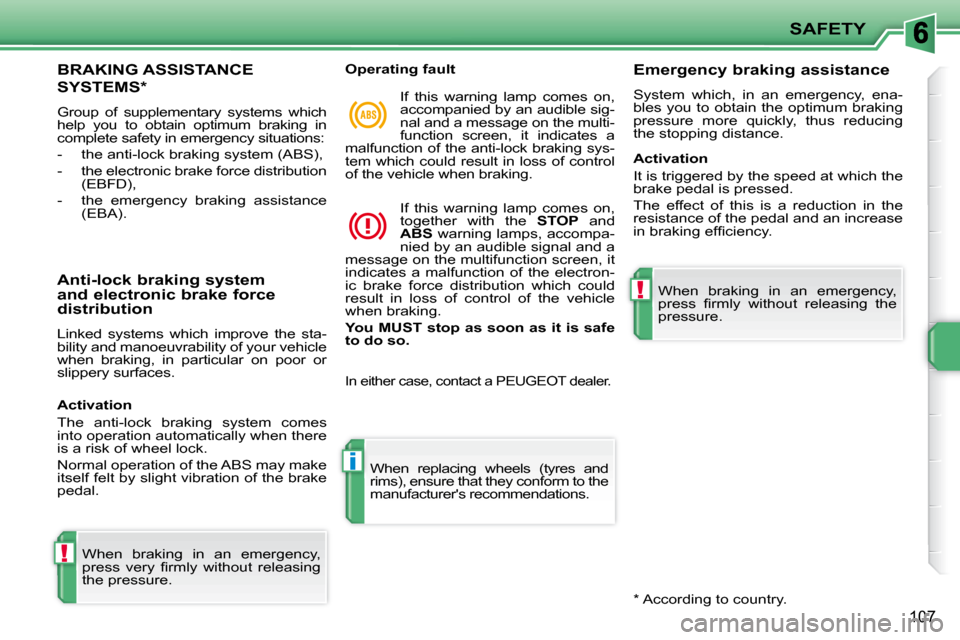
!
i
!
SAFETY
107
BRAKING ASSISTANCE
SYSTEMS *
Group of supplementary systems which help you to obtain optimum braking in complete safety in emergency situations:
- the anti-lock braking system (ABS),
-the electronic brake force distribution (EBFD),
- the emergency braking assistance (EBA).
Anti-lock braking system
and electronic brake force
distribution
Linked systems which improve the sta-
bility and manoeuvrability of your vehicle
when braking, in particular on poor or
slippery surfaces. When braking in an emergency,
�p�r�e�s�s� �v�e�r�y� �fi� �r�m�l�y� �w�i�t�h�o�u�t� �r�e�l�e�a�s�i�n�g�
the pressure. When replacing wheels (tyres and
rims), ensure that they conform to the
manufacturer's recommendations.
Operating fault
If this warning lamp comes on,
accompanied by an audible sig-
nal and a message on the multi-
function screen, it indicates a
malfunction of the anti-lock braking sys-
tem which could result in loss of control
of the vehicle when braking.
If this warning lamp comes on,
together with the STOP and
ABS warning lamps, accompa-
nied by an audible signal and a
message on the multifunction screen, it
indicates a malfunction of the electron-
ic brake force distribution which could
result in loss of control of the vehicle
when braking.
You MUST stop as soon as it is safe
to do so. Emergency braking assistance
System which, in an emergency, ena-
bles you to obtain the optimum braking
pressure more quickly, thus reducing
the stopping distance.
Activation
The anti-lock braking system comes
into operation automatically when there
is a risk of wheel lock.
Normal operation of the ABS may make
itself felt by slight vibration of the brake
pedal. Activation
It is triggered by the speed at which the
brake pedal is pressed.
The effect of this is a reduction in the
resistance of the pedal and an increase
�i�n� �b�r�a�k�i�n�g� �e�f�fi� �c�i�e�n�c�y�.�
* According to country.
In either case, contact a PEUGEOT dealer.
When braking in an emergency,
�p�r�e�s�s� �fi� �r�m�l�y� �w�i�t�h�o�u�t� �r�e�l�e�a�s�i�n�g� �t�h�e�
pressure.
Page 102 of 267
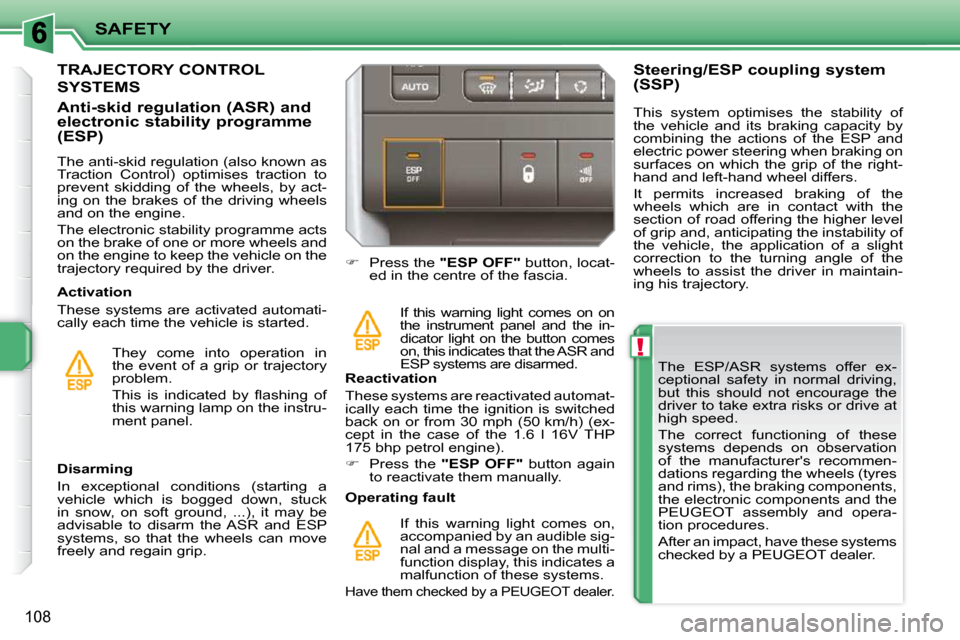
!
SAFETY
108
The ESP/ASR systems offer ex-
ceptional safety in normal driving,
but this should not encourage the
driver to take extra risks or drive at
high speed.
The correct functioning of these
systems depends on observation
of the manufacturer's recommen-
dations regarding the wheels (tyres
and rims), the braking components,
the electronic components and the
PEUGEOT assembly and opera-
tion procedures.
After an impact, have these systems
checked by a PEUGEOT dealer.
Disarming
In exceptional conditions (starting a
vehicle which is bogged down, stuck
in snow, on soft ground, ...), it may be
advisable to disarm the ASR and ESP
systems, so that the wheels can move
freely and regain grip.
� Press the "ESP OFF" button, locat-
ed in the centre of the fascia.
If this warning light comes on on
the instrument panel and the in-
dicator light on the button comes
on, this indicates that the ASR and
ESP systems are disarmed.
Reactivation
These systems are reactivated automat-
ically each time the ignition is switched
�b�a�c�k� �o�n� �o�r� �f�r�o�m� �3�0� �m�p�h� �(�5�0� �k�m�/�h�)� �(�e�x�-
cept in the case of the 1.6 l 16V THP
175 bhp petrol engine).
� Press the "ESP OFF" button again
to reactivate them manually.
Operating fault
If this warning light comes on,
accompanied by an audible sig-
nal and a message on the multi-
function display, this indicates a
malfunction of these systems.
Have them checked by a PEUGEOT dealer.
TRAJECTORY CONTROL
SYSTEMS
Activation
These systems are activated automati-
cally each time the vehicle is started.
Anti-skid regulation (ASR) and
electronic stability programme
(ESP)
They come into operation in
�t�h�e� �e�v�e�n�t� �o�f� �a� �g�r�i�p� �o�r� �t�r�a�j�e�c�t�o�r�y�
problem.
� �T�h�i�s� �i�s� �i�n�d�i�c�a�t�e�d� �b�y� �fl� �a�s�h�i�n�g� �o�f�
this warning lamp on the instru-
ment panel. Steering/ESP coupling system
(SSP)
The anti-skid regulation (also known as
Traction Control) optimises traction to
prevent skidding of the wheels, by act-
ing on the brakes of the driving wheels
and on the engine.
The electronic stability programme acts
on the brake of one or more wheels and
on the engine to keep the vehicle on the
�t�r�a�j�e�c�t�o�r�y� �r�e�q�u�i�r�e�d� �b�y� �t�h�e� �d�r�i�v�e�r�.� � This system optimises the stability of
the vehicle and its braking capacity by
combining the actions of the ESP and
electric power steering when braking on
surfaces on which the grip of the right-
hand and left-hand wheel differs.
It permits increased braking of the
wheels which are in contact with the
section of road offering the higher level
of grip and, anticipating the instability of
the vehicle, the application of a slight
correction to the turning angle of the
wheels to assist the driver in maintain-
�i�n�g� �h�i�s� �t�r�a�j�e�c�t�o�r�y�.� � � �
Page 103 of 267
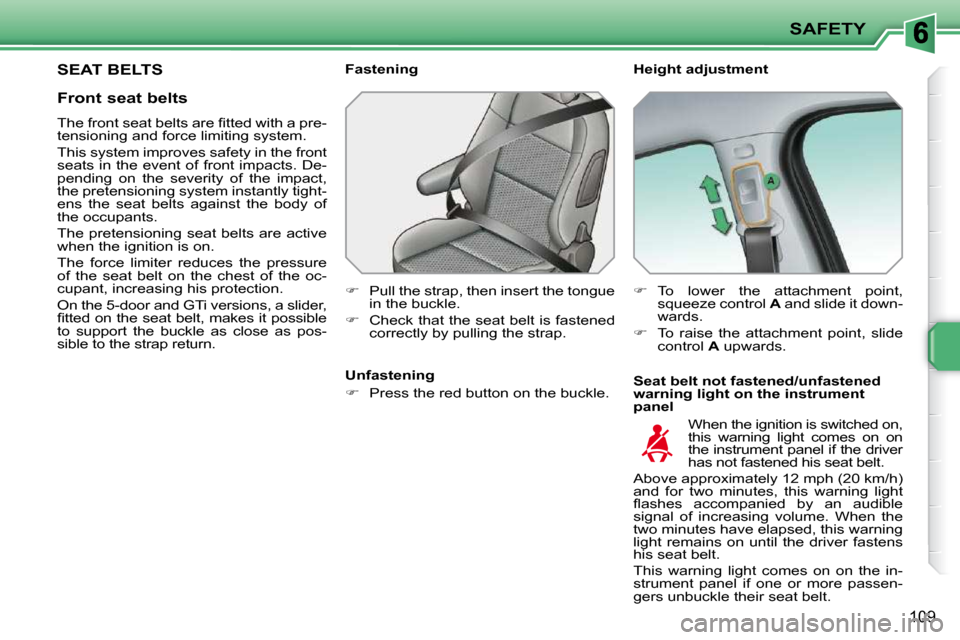
SAFETY
109
SEAT BELTS Height adjustment
Seat belt not fastened/unfastened
warning light on the instrument
panel
Fastening
� Pull the strap, then insert the tongue
in the buckle.
� Check that the seat belt is fastened
correctly by pulling the strap.
� To lower the attachment point,
squeeze control A and slide it down-
wards.
� To raise the attachment point, slide
control A upwards.
When the ignition is switched on,
this warning light comes on on
the instrument panel if the driver
has not fastened his seat belt.
Above approximately 12 mph (20 km/h)
and for two minutes, this warning light
�fl� �a�s�h�e�s� �a�c�c�o�m�p�a�n�i�e�d� �b�y� �a�n� �a�u�d�i�b�l�e�
signal of increasing volume. When the
two minutes have elapsed, this warning
light remains on until the driver fastens
his seat belt.
This warning light comes on on the in-
strument panel if one or more passen-
gers unbuckle their seat belt.
Unfastening
� Press the red button on the buckle.
Front seat belts
� �T�h�e� �f�r�o�n�t� �s�e�a�t� �b�e�l�t�s� �a�r�e� �fi� �t�t�e�d� �w�i�t�h� �a� �p�r�e�-
tensioning and force limiting system.
This system improves safety in the front
seats in the event of front impacts. De-
pending on the severity of the impact,
the pretensioning system instantly tight-
ens the seat belts against the body of
the occupants.
The pretensioning seat belts are active
when the ignition is on.
The force limiter reduces the pressure
of the seat belt on the chest of the oc-
cupant, increasing his protection.
On the 5-door and GTi versions, a slider,
�fi� �t�t�e�d� �o�n� �t�h�e� �s�e�a�t� �b�e�l�t�,� �m�a�k�e�s� �i�t� �p�o�s�s�i�b�l�e�
to support the buckle as close as pos-
sible to the strap return.
Page 104 of 267
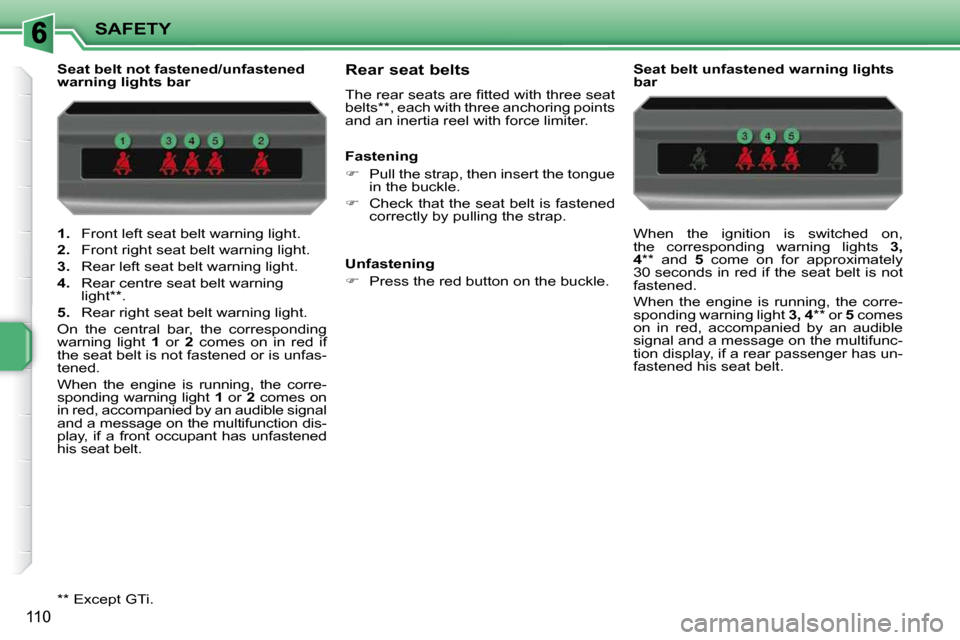
SAFETY
110
1. Front left seat belt warning light.
2. Front right seat belt warning light.
3. Rear left seat belt warning light.
4. Rear centre seat belt warning
light ** .
5. Rear right seat belt warning light.
On the central bar, the corresponding
warning light 1 or 2 comes on in red if
the seat belt is not fastened or is unfas-
tened.
When the engine is running, the corre-
sponding warning light 1 or 2 comes on
in red, accompanied by an audible signal
and a message on the multifunction dis-
play, if a front occupant has unfastened
his seat belt.
Seat belt not fastened/unfastened
warning lights bar
Rear seat belts
� �T�h�e� �r�e�a�r� �s�e�a�t�s� �a�r�e� �fi� �t�t�e�d� �w�i�t�h� �t�h�r�e�e� �s�e�a�t�
belts ** , each with three anchoring points
and an inertia reel with force limiter. Seat belt unfastened warning lights
bar
When the ignition is switched on,
the corresponding warning lights
3,
4 ** and 5 come on for approximately
�3�0� �s�e�c�o�n�d�s� �i�n� �r�e�d� �i�f� �t�h�e� �s�e�a�t� �b�e�l�t� �i�s� �n�o�t�
fastened.
When the engine is running, the corre-
sponding warning light 3, 4 ** or 5 comes
on in red, accompanied by an audible
signal and a message on the multifunc-
tion display, if a rear passenger has un-
fastened his seat belt.
Fastening
� Pull the strap, then insert the tongue
in the buckle.
� Check that the seat belt is fastened
correctly by pulling the strap.
Unfastening
� Press the red button on the buckle.
** Except GTi.
Page 105 of 267
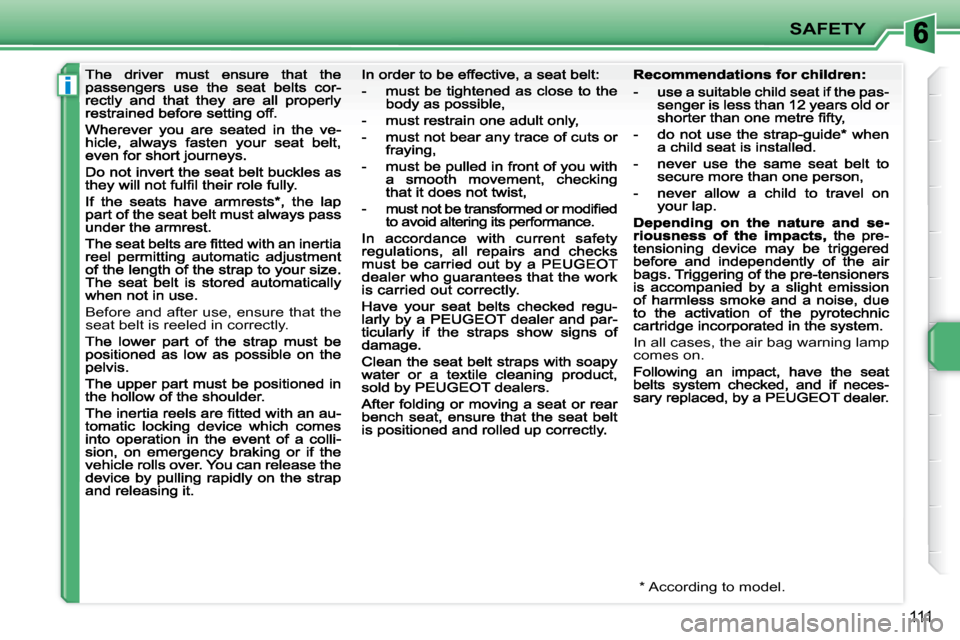
i
SAFETY
111
Before and after use, ensure that the
seat belt is reeled in correctly.
* According to model.
In all cases, the air bag warning lamp
comes on.
Page 106 of 267
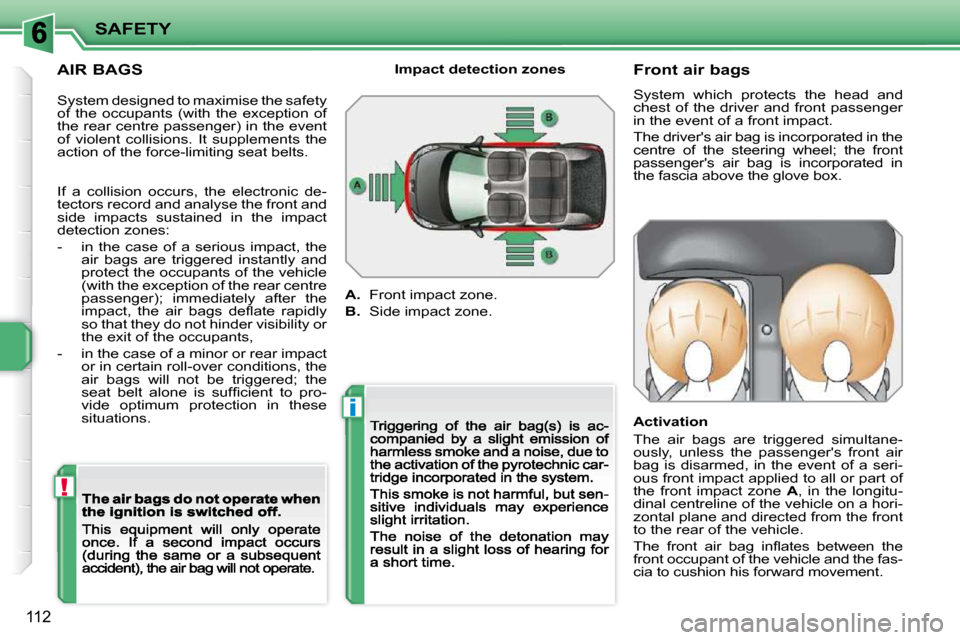
!
i
SAFETY
112
AIR BAGS Front air bags
System which protects the head and
chest of the driver and front passenger
in the event of a front impact.
The driver's air bag is incorporated in the
centre of the steering wheel; the front
passenger's air bag is incorporated in
the fascia above the glove box.
Activation
The air bags are triggered simultane-
ously, unless the passenger's front air
bag is disarmed, in the event of a seri-
ous front impact applied to all or part of
the front impact zone A , in the longitu-
dinal centreline of the vehicle on a hori-
zontal plane and directed from the front
to the rear of the vehicle.
� �T�h�e� �f�r�o�n�t� �a�i�r� �b�a�g� �i�n�fl� �a�t�e�s� �b�e�t�w�e�e�n� �t�h�e�
front occupant of the vehicle and the fas-
cia to cushion his forward movement. Impact detection zones
A. Front impact zone.
B. Side impact zone.
System designed to maximise the safety of the occupants (with the exception of the rear centre passenger) in the event of violent collisions. It supplements the action of the force-limiting seat belts.
If a collision occurs, the electronic de-tectors record and analyse the front and side impacts sustained in the impact detection zones:
- in the case of a serious impact, the air bags are triggered instantly and protect the occupants of the vehicle (with the exception of the rear centre passenger); immediately after the �i�m�p�a�c�t�,� �t�h�e� �a�i�r� �b�a�g�s� �d�e�fl� �a�t�e� �r�a�p�i�d�l�y� so that they do not hinder visibility or the exit of the occupants,
- in the case of a minor or rear impact or in certain roll-over conditions, the air bags will not be triggered; the �s�e�a�t� �b�e�l�t� �a�l�o�n�e� �i�s� �s�u�f�fi� �c�i�e�n�t� �t�o� �p�r�o�-vide optimum protection in these situations.
Page 107 of 267
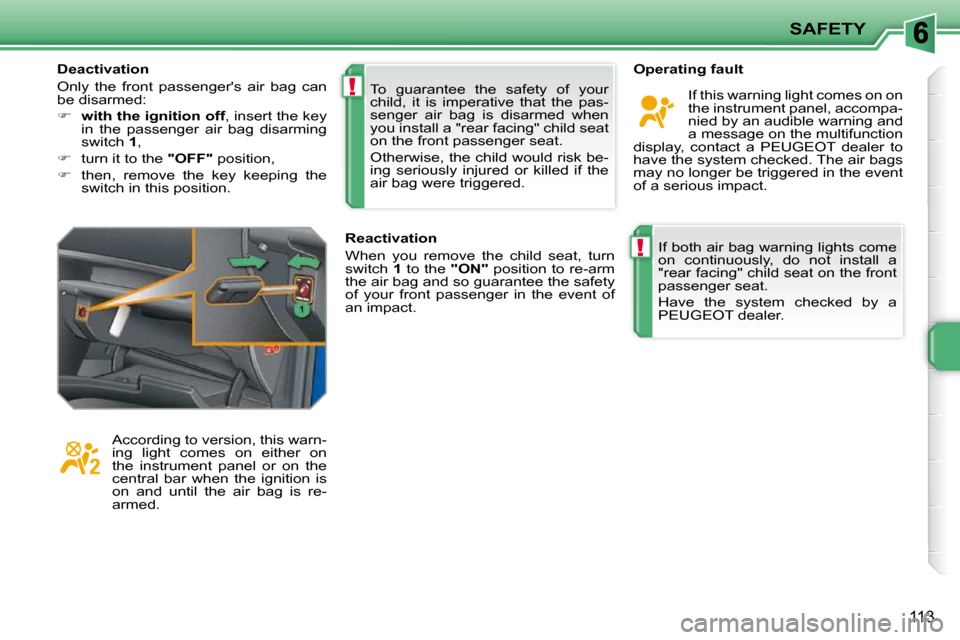
!
!
SAFETY
�1�1�3
If both air bag warning lights come
on continuously, do not install a
"rear facing" child seat on the front
passenger seat.
Have the system checked by a
PEUGEOT dealer.
Operating fault
If this warning light comes on on
the instrument panel, accompa-
nied by an audible warning and
a message on the multifunction
display, contact a PEUGEOT dealer to
have the system checked. The air bags
may no longer be triggered in the event
of a serious impact.
To guarantee the safety of your
child, it is imperative that the pas-
senger air bag is disarmed when
you install a "rear facing" child seat
on the front passenger seat.
Otherwise, the child would risk be-
�i�n�g� �s�e�r�i�o�u�s�l�y� �i�n�j�u�r�e�d� �o�r� �k�i�l�l�e�d� �i�f� �t�h�e�
air bag were triggered.
According to version, this warn-
ing light comes on either on
the instrument panel or on the
central bar when the ignition is
on and until the air bag is re-
armed. Reactivation
When you remove the child seat, turn
switch
1 to the "ON" position to re-arm
the air bag and so guarantee the safety
of your front passenger in the event of
an impact.
Deactivation
Only the front passenger's air bag can
be disarmed:
� with the ignition off , insert the key
in the passenger air bag disarming
switch 1 ,
� turn it to the "OFF" position,
� then, remove the key keeping the
switch in this position.
Page 108 of 267
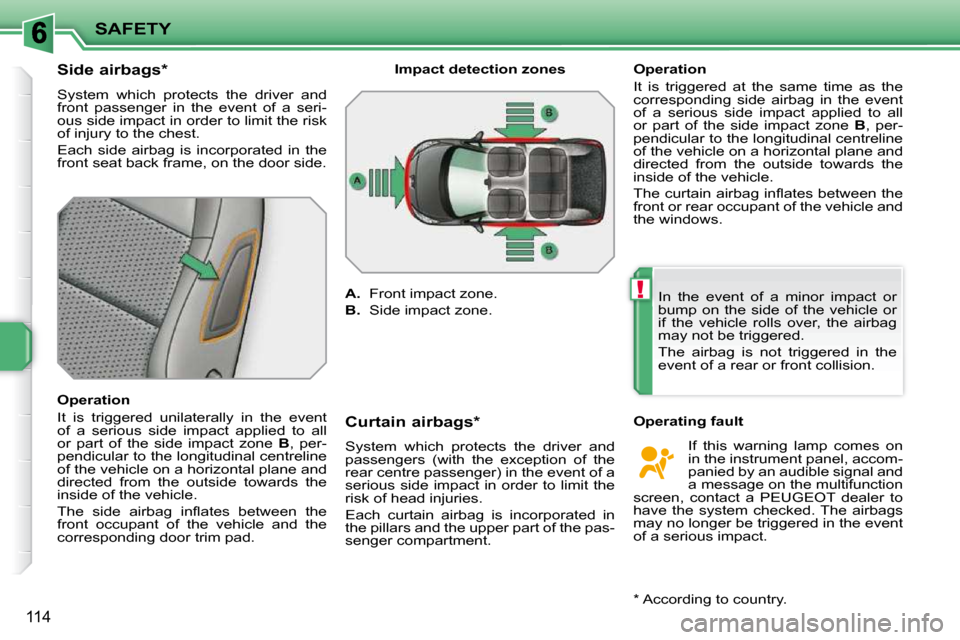
!
SAFETY
114
Side airbags *
System which protects the driver and
front passenger in the event of a seri-
ous side impact in order to limit the risk
�o�f� �i�n�j�u�r�y� �t�o� �t�h�e� �c�h�e�s�t�.�
Each side airbag is incorporated in the
front seat back frame, on the door side.
Operation
It is triggered unilaterally in the event
of a serious side impact applied to all
or part of the side impact zone B , per-
pendicular to the longitudinal centreline
of the vehicle on a horizontal plane and
directed from the outside towards the
inside of the vehicle.
� �T�h�e� �s�i�d�e� �a�i�r�b�a�g� �i�n�fl� �a�t�e�s� �b�e�t�w�e�e�n� �t�h�e�
front occupant of the vehicle and the
corresponding door trim pad. Curtain airbags *
System which protects the driver and
passengers (with the exception of the
rear centre passenger) in the event of a
serious side impact in order to limit the
�r�i�s�k� �o�f� �h�e�a�d� �i�n�j�u�r�i�e�s�.�
Each curtain airbag is incorporated in
the pillars and the upper part of the pas-
senger compartment.
If this warning lamp comes on
in the instrument panel, accom-
panied by an audible signal and
a message on the multifunction
screen, contact a PEUGEOT dealer to
have the system checked. The airbags
may no longer be triggered in the event
of a serious impact.
* According to country.
Operating fault
Operation
It is triggered at the same time as the
corresponding side airbag in the event
of a serious side impact applied to all
or part of the side impact zone
B , per-
pendicular to the longitudinal centreline
of the vehicle on a horizontal plane and
directed from the outside towards the
inside of the vehicle.
� �T�h�e� �c�u�r�t�a�i�n� �a�i�r�b�a�g� �i�n�fl� �a�t�e�s� �b�e�t�w�e�e�n� �t�h�e�
front or rear occupant of the vehicle and
the windows.
In the event of a minor impact or
bump on the side of the vehicle or
if the vehicle rolls over, the airbag
may not be triggered.
The airbag is not triggered in the
event of a rear or front collision.
Impact detection zones
A. Front impact zone.
B. Side impact zone.
Page 109 of 267
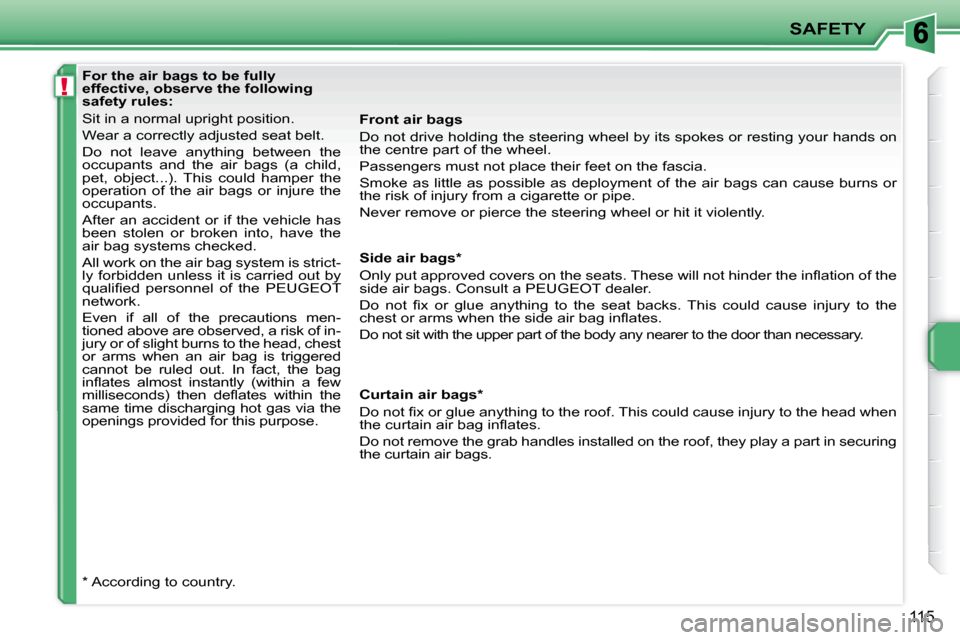
!
SAFETY
115
Front air bags
Do not drive holding the steering wheel by its spokes or resting your hands on
the centre part of the wheel.
Passengers must not place their feet on the fascia.
Smoke as little as possible as deployment of the air bags can ca use burns or
�t�h�e� �r�i�s�k� �o�f� �i�n�j�u�r�y� �f�r�o�m� �a� �c�i�g�a�r�e�t�t�e� �o�r� �p�i�p�e�.�
Never remove or pierce the steering wheel or hit it violently.
Side air bags *
� �O�n�l�y� �p�u�t� �a�p�p�r�o�v�e�d� �c�o�v�e�r�s� �o�n� �t�h�e� �s�e�a�t�s�.� �T�h�e�s�e� �w�i�l�l� �n�o�t� �h�i�n�d�e�r� �t�h�e� �i�n�fl� �a�t�i�o�n� �o�f� �t�h�e�
side air bags. Consult a PEUGEOT dealer.
� �D�o� �n�o�t� �fi� �x� �o�r� �g�l�u�e� �a�n�y�t�h�i�n�g� �t�o� �t�h�e� �s�e�a�t� �b�a�c�k�s�.� �T�h�i�s� �c�o�u�l�d� �c�a �u�s�e� �i�n�j�u�r�y� �t�o� �t�h�e�
�c�h�e�s�t� �o�r� �a�r�m�s� �w�h�e�n� �t�h�e� �s�i�d�e� �a�i�r� �b�a�g� �i�n�fl� �a�t�e�s�.�
Do not sit with the upper part of the body any nea rer to the door than necessary.
Curtain air bags *
� �D�o� �n�o�t� �fi� �x� �o�r� �g�l�u�e� �a�n�y�t�h�i�n�g� �t�o� �t�h�e� �r�o�o�f�.� �T�h�i�s� �c�o�u�l�d� �c�a�u�s�e� �i�n�j�u�r�y� �t�o� �t�h�e� �h�e�a�d� �w�h�e�n�
�t�h�e� �c�u�r�t�a�i�n� �a�i�r� �b�a�g� �i�n�fl� �a�t�e�s�.�
Do not remove the grab handles installed on the ro of, they play a part in securing
the curtain air bags.
* According to country.
For the air bags to be fully
effective, observe the following
safety rules:
Sit in a normal upright position.
� �W�e�a�r� �a� �c�o�r�r�e�c�t�l�y� �a�d�j�u�s�t�e�d� �s�e�a�t� �b�e�l�t�.�
Do not leave anything between the
occupants and the air bags (a child,
�p�e�t�,� �o�b�j�e�c�t�.�.�.�)�.� �T�h�i�s� �c�o�u�l�d� �h�a�m�p�e�r� �t�h�e�
�o�p�e�r�a�t�i�o�n� �o�f� �t�h�e� �a�i�r� �b�a�g�s� �o�r� �i�n�j�u�r�e� �t�h�e�
occupants.
After an accident or if the vehicle has
been stolen or broken into, have the
air bag systems checked.
All work on the air bag system is strict-
ly forbidden unless it is carried out by
�q�u�a�l�i�fi� �e�d� �p�e�r�s�o�n�n�e�l� �o�f� �t�h�e� �P�E�U�G�E�O�T�
network.
Even if all of the precautions men-
tioned above are observed, a risk of in-
�j�u�r�y� �o�r� �o�f� �s�l�i�g�h�t� �b�u�r�n�s� �t�o� �t�h�e� �h�e�a�d�,� �c�h�e�s�t�
or arms when an air bag is triggered
cannot be ruled out. In fact, the bag
�i�n�fl� �a�t�e�s� �a�l�m�o�s�t� �i�n�s�t�a�n�t�l�y� �(�w�i�t�h�i�n� �a� �f�e�w�
�m�i�l�l�i�s�e�c�o�n�d�s�)� �t�h�e�n� �d�e�fl� �a�t�e�s� �w�i�t�h�i�n� �t�h�e�
same time discharging hot gas via the
openings provided for this purpose.
Page 110 of 267
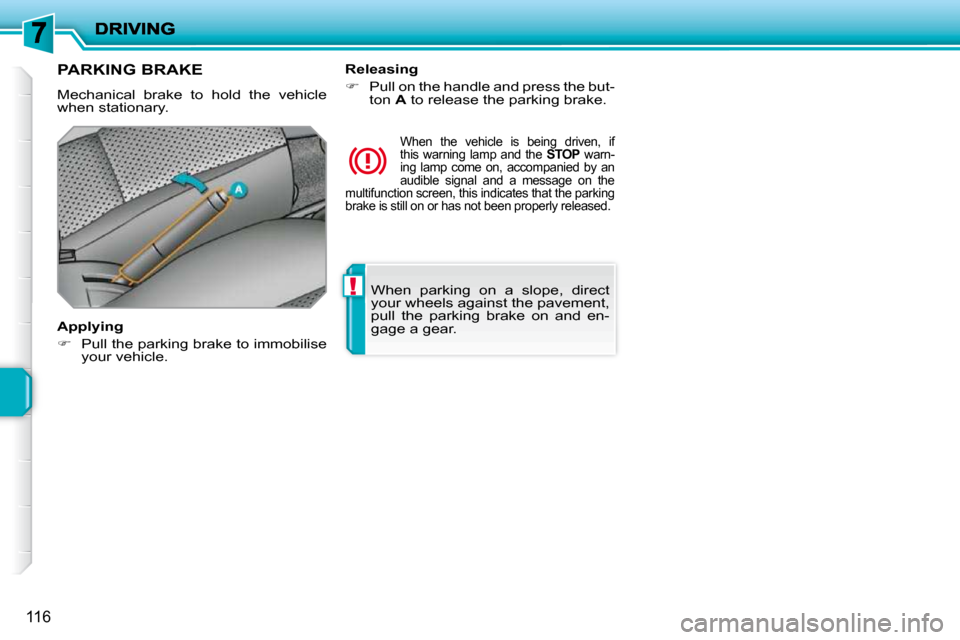
!
116
When parking on a slope, direct
your wheels against the pavement,
pull the parking brake on and en-
gage a gear.
PARKING BRAKE
Mechanical brake to hold the vehicle when stationary.
Applying
� Pull the parking brake to immobilise
your vehicle.
When the vehicle is being driven, if
this warning lamp and the
STOP warn-
ing lamp come on, accompanied by an
audible signal and a message on the
multifunction screen, this indicates that the parki ng
brake is still on or has not been properly released .
Releasing
� Pull on the handle and press the but-
ton A to release the parking brake.